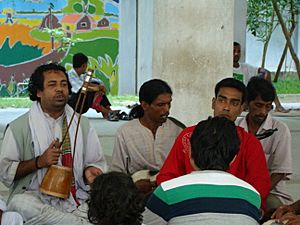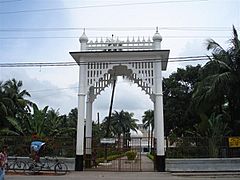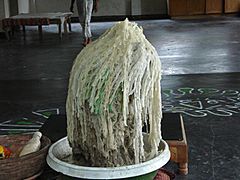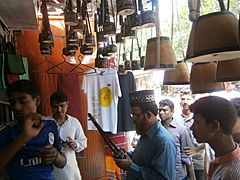Lalon facts for kids
Quick facts for kids
Baul Shamrat, বাউল সম্রাট
Fakir Lalon
Sai, Sain, Shah, Shai ji
|
|
|---|---|
| লালন | |
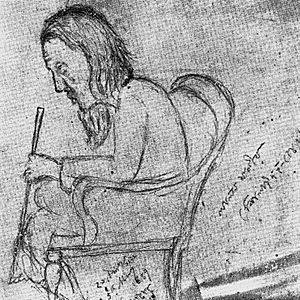 |
|
| Born | 17 October 1774 |
| Died | 17 October 1890 (aged 117–118) |
| Resting place | Cheuriya, Kushtia, Bangladesh |
| Title | Baul Shamrat |
| Spouse(s) | Bishōkha |
Lalon, also known as Fakir Lalon Shah, was a very important Bengali philosopher, saint, and songwriter. He lived in British India from 1774 to 1890. Lalon was a deep thinker who wrote many songs. He is seen as a symbol of Bengali culture. Many famous people, like Rabindranath Tagore, were inspired by him. Lalon believed that everyone should be treated equally, no matter their religion or background.
He is famous for promoting religious tolerance. He dreamed of a world where all religions could live together peacefully. However, some people didn't understand his ideas and even accused him of having wrong beliefs.
Lalon started a special place called Lalon Akhrah in Cheuriya, Bangladesh. His followers, called disciples, still live there today. Every year, on the day he passed away, thousands of his followers gather at Lalon Akhrah. They honor him by celebrating and discussing his songs and ideas for three days.
In 2004, Lalon was ranked number 12 in a BBC poll of the Greatest Bengali of all time.
Contents
Lalon's Life Story
It's hard to know many details about Lalon's early life. He didn't talk much about his past. We don't know if he was born into a Hindu or a Muslim family. Lalon also didn't go to a formal school.
One story says that Lalon was on a trip to a temple when he got very sick with smallpox. His friends left him by a river. A kind couple, Malam Shah and his wife Matijan, found him. They were weavers from a Muslim village called Cheuriya. They took Lalon to their home and helped him get better.
Lalon stayed in Cheuriya. He started a music group there and wrote many songs. He was inspired by a musician named Siraj Sain from that village. Lalon lost sight in one eye because of smallpox. Researchers say Lalon was good friends with Kangal Harinath, who was a social reformer and also Lalon's student.
Lalon lived near the Tagore family's land in Kushtia. He even visited the Tagore family. It is said that Jyotirindranath Tagore drew the only known picture of Lalon in 1889. Lalon passed away in Chheuriya on October 17, 1890, at the age of 118. The news of his death was first printed in a newspaper run by Kangal Harinath. Lalon was buried in the middle of his home, which is now known as his Akhra.
Lalon's Beliefs and Ideas
Lalon was against religious arguments and fighting. Many of his songs make fun of ideas that divide people and cause violence. He even disagreed with strong nationalistic feelings during the time when people were fighting for independence in India. He didn't believe in different social classes or castes. He stood against racism and believed everyone was equal.
Lalon's ideas were not just about spiritual things. He believed that music could change how people think and feel. This change could help them understand and enjoy life more.
His songs talk about deep philosophical ideas from Bengal. He took ideas from Hinduism, Jainism, Buddhism, and Islam. He combined them into his own clear way of thinking. He was greatly influenced by Chaitanya Mahaprabhu, who started a movement against differences in caste, beliefs, and religion. Lalon's songs show that it's not important to divide people based on what they believe.
Lalon's Songs and Works
Lalon wrote many songs and poems that explain his ideas. It's thought that he composed between 2,000 and 10,000 songs. However, only about 800 of these are generally believed to be truly his. Lalon didn't write down his songs himself. They were passed down by word of mouth and later written by his followers. Since most of his followers couldn't read or write, only a few of his songs were found in written form. Rabindranath Tagore published some of Lalon's songs in a magazine called Prabasi.
Some of his most popular songs include:
- Shob Loke Koy Lalon Ki Jat Shongshare
- Khachar Bhitor Ochin Pakhi kyamne ashe jaay
- Jat Gelo Jat Gelo Bole
- Dekhna Mon Jhokmariay Duniyadari
- Pare Loye Jao Amai
- Milon Hobe Koto Dine
- Ar Amare Marishne Ma
- Tin Pagoler Holo Mela
- Dhonno Dhonno Boli Tare
- Emon Manob Jonom Aar Ki Hobe
Lalon's songs talk about a reality that goes beyond what we can see and touch. He paid close attention to society and wrote about everyday problems. He used simple but powerful language. His ideas were shared through his songs and music. He used folk instruments like the ektara (a one-string instrument) and the duggi (drum), which could be made from things found at home.
For a long time, Lalon's songs were mostly known by the Baul groups. After Bangladesh became independent, famous singers helped his songs reach people in cities. Many singers started using other instruments besides the ektara and baya. Some even used classical music styles to make the songs sound more polished for city audiences.
According to Farida Parveen, a well-known Lalon singer, the words in the songs were also made clearer. This was done to make their meanings easier to understand, as the Bauls' way of speaking might have had local accents.
Gallery
-
Tomb of Lalon, Kushtia District.
Images for kids



